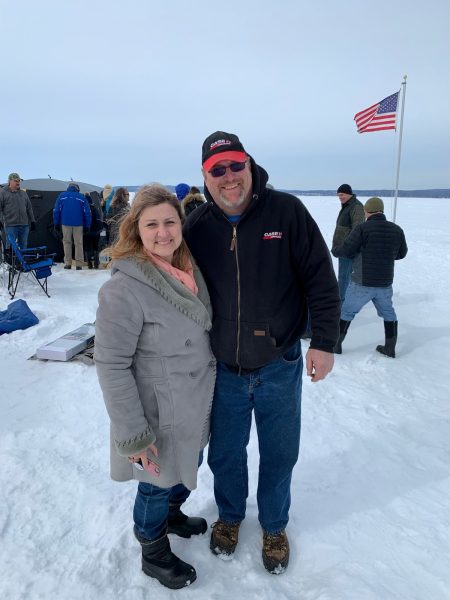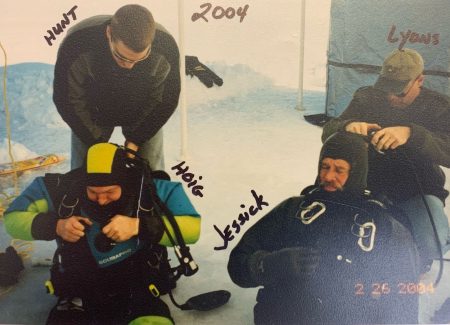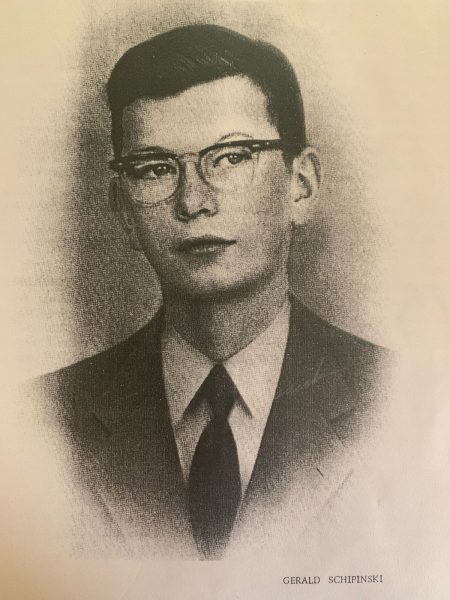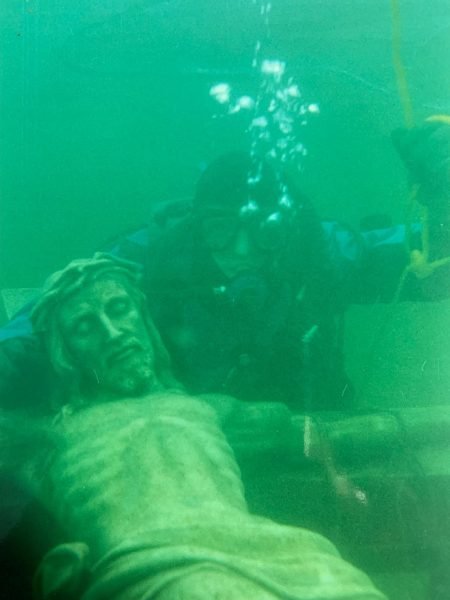About twenty feet underwater in Lake Michigan there’s a white marble crucifix from Italy. Diver Denny Jessick used a trail of rumors to search for its origin story.
By Morgan Springer
The following transcript is from an episode of Points North, a narrative podcast about the land, water, and inhabitants of the Great Lakes. Listen to more episodes at pointsnorthpodcast.org.
or
Listen along while you read below.
(SPOTIFY EMBED LINK)
https://open.spotify.com/episode/3kND4sAGmhU4jx9SR4GH2J?si=eb60a2fb40824dbe
TRANSCRIPT
DANIEL WANSCHURA, HOST: It’s 2019. A long line of people are standing on top of about two feet of ice on Lake Michigan. And they’re waiting. Eventually, Arlene Schipinski and her husband are brought to the front of the line.
ARLENE SCHIPINSKI: And then they took us to the tent, and they lifted the flap and we went in there. … And you look down there, and the water was very, very clear … It looked like only a foot or two under the water, but it’s probably what, 12 or 15 feet? … It just seemed like it was right there though.
WANSCHURA: It is a crucifix, laying on the bottom of the lakebed. And it’s actually about 20 feet down. The cross itself is long – 11 feet, and Jesus Christ is life-sized. It’s cut from white Italian marble. Arlene says, standing there looking down at the crucifix, it felt kind of like church.
SCHIPINSKI: With the waves, the ripples on the cross. It was just very surreal, very peaceful.
WANSCHURA: Arlene and her husband say a prayer. And then they leave the tent, walking back across the ice to the shore of Petoskey, Michigan. This underwater crucifix is one of only a few in the world. When the ice is thick enough in winter, a group organizes a viewing. Arlene was there because more than a decade earlier, a mystery had been solved. And it was a mystery that mattered to her family.

Arlene and Bob Schipinski at the 2019 viewing. (Dennis Jessick)
DAN WANSCHURA: This is Points North, a show about the land, water and inhabitants of the Great Lakes. I’m Dan Wanschura. Today, producer Morgan Springer is going to bring us the origin story of a European crucifix in Lake Michigan.
MORGAN SPRINGER, REPORTER: This is the story of the underwater crucifix and that mystery. And this is the man who cared enough to solve it.
DENNIS JESSICK: My name is Dennis Jessick. I live in Harbor Springs, Michigan.
SPRINGER: Dennis goes by Denny. He’s a diver. In the 70s, he dove and saw the crucifix for the first time. He saw it many times over the years. Then, in 1986, Denny got the idea of a winter viewing, and he and a group of volunteers organized the first event. More than 300 people came. And they kept doing it. Whenever the ice was thick enough, people would come to commemorate those who died at sea. But, for years, something kept bothering Denny. No one exactly knew why the crucifix had been made in the first place. There was a rumor that it was originally for a teenager who died in a car accident. For some reason, Denny doubted that rumor.
JESSICK: Nobody chose to go forward. … And I could have been just like them and allow history to pass on and allow false information to be delivered. But that was just not going to be my forte. So I decided, whatever it takes, I’m gonna hunt this down.
SPRINGER: Part of the reason Denny cared so much is because the crucifix has a personal significance for him. For the past 45 years, he’s been a sergeant for the local county sheriff’s marine and snowmobile division.
JESSICK: We do search and rescue missions, body recovery, evidence recovery –
SPRINGER: And have you been in situations, in your professional capacity, where you have found people who have died in the water?
JESSICK: Approximately eighteen.
SPRINGER: Wow.
JESSICK: So when I look at the crucifix, I’m thinking of all the people in the world, and it’s fair to say that, that have perished in some water related item. … And we … are put into a almost out of body experience of seeing before us that closure. And that stays with you. You never really forget that.

Dennis Jessick (bottom right) and Rick Hoig (bottom left) preparing to dive to the underwater crucifix ahead of the public viewing in the winter of 2004. (Courtesy of Dennis Jessick)
SPRINGER: Denny started hunting for the origin of this crucifix in the early 2000s. The rumor about the boy was his clue. Part of the rumor was the teen died in Bad Axe, Michigan. So, Denny and his wife got in the car and drove nearly four hours there. First, they talked to a local historian. He suggested they talk to a priest. So they went over to the Catholic church in Bad Axe. And there they found something.
JESSICK: We did, in the death records, locate a young man of 17 years of age that died in a car accident.
SPRINGER: The accident happened in the late 50s – around the time they were looking for – and the boy’s name was Gerald Talaski. It seemed promising. Now another part of the rumor was that the boy was buried near a crucifix just like the one underwater in Lake Michigan. So, Denny asked if this Gerald Talaski had a gravesite there.
JESSICK: And he said, no, that name is not here in our cemetery, but I suggest you go to Rapson, Michigan, which was about five miles away.
SPRINGER: They arrived in Rapson, and there, at the back of the cemetery, they found a small marker with the name Talaski – but no big crucifix by it. So they wanted to see if he had family in the area. Denny and his wife asked around and were told, ‘yeah, try the Schipinskis at their farm down the road’, which didn’t quite make sense. It was the wrong last name, but they went anyway.

The Schipinski Farm in Rapson, Michigan – as seen by Denny and his wife as they searched for the origin of the crucifix. (Dennis Jessick)
ROBERT SCHIPINSKI: I think I was coming from the barn walking to the house, and this vehicle pulls in and–
SPRINGER: This is farmer Robert Schipinski; he goes by Bob. He’s also married to Arlene, who you heard at the beginning of this episode.
SCHIPINSKI: –this couple pull gets out.
SPRINGER: The couple, of course, is Denny and his wife.
SCHIPINSKI: He asked me if I could help him to solve a 40 year mystery, and I didn’t know this person. I says, ‘Well, I can try,’ you know.
SPRINGER: Denny tells farmer Bob about the underwater crucifix – about the rumor that it was made for a young boy named Gerald Talaski. They’d just found his gravesite.
SCHIPINSKI: Well, then I told him that, ‘Well, it’s not Talaski what you’re looking for, it’s Schipinski, and you’ve found the right place.
SPRINGER: Bob tells Denny he suspects this because after his brother Gerald died, his parents bought a crucifix to commemorate him.

The Schipinski family in 1945. From left to right: Beverly, Gerald, Leona, Matt, Joyce and Tippy the dog. (Courtesy of the Schipinskis)
SPRINGER: Bob was born after Gerald died, but this was the story he was told. It was 1956. Gerald was 15 – a freshman in high school, growing up on the family farm.
SCHIPINSKI: He went out to a field to bring a ditcher home, so he went with a tractor. … There was some crows out there. He thought, well, he’ll shoot some crows while he was out there. Gerald grabs his gun and takes off in the tractor across the field. Till at one point – the gun started falling. And it accidentally discharged into Gerald’s chest. I remember my one sister saying that my dad was on a field nearby and could see the tractor. … And he sensed something was wrong, and he ran home and got in the car and drove out there and seen what happened. And he grabbed him, carried him into the car and rushed him to the hospital, but he passed away. Gerald liked horses and hunting, reading and playing monopoly with his sister.

Gerald Schipinski was an altar boy at St. Joseph Catholic Church in Rapson, Michigan. (Courtesy of the Schipinskis)
SPRINGER: His sister didn’t want to be recorded for this story, but she says after Gerald died, her parents decided to order a crucifix and erect it at the Catholic church down the road. They ordered one from Italy. They were Catholic. You’re Catholic. I don’t think it’s typical, and you can correct me if I’m wrong, for Catholics to get a crucifix –
SCHIPINSKI: Right. Right.
SPRINGER: – for a loved one who passes on.
SCHIPINSKI: Yes.
SPRINGER: Were you around when that decision was made, I can’t remember now?
SCHIPINSKI: I think that decision was made before I came around, … but it was just something they just wanted to do.
SPRINGER: No one can remember how they ordered it or why it was from Italy. But records show they paid $2,500 for it, which in the early 60s was a lot of money. When the crucifix arrived though, it was broken. Jerry’s parents weren’t going to commemorate their son with a broken crucifix. So, they ordered a second one with insurance money from the first. And the broken crucifix from Italy just sat there in a crate at the back of the church.

Gerald Schipinski (Courtesy of Dennis Jessick and the Schipinskis)
(Church bells, birds)
SPRINGER: About a year later, the Superior Marine Divers Club bought it for $50 in an insurance sale. They brought it up north to Petoskey, Michigan. And there the crucifix, which weighs nearly 2,000 pounds, was lowered carefully into the clear water of Little Traverse Bay. It was 1962 – six years after Gerald died. Initially, the underwater crucifix was put there to commemorate a diver who had drowned. But then the divers club decided to expand it to anyone who died at sea. Somewhere along the way, Gerald Schipinski’s story got lost. But Denny had found it – after more than 40 years of rumors and questions. Now, Denny sat at the Schipinskis’ kitchen table looking at a photo of Gerald.
JESSICK: It became a very personal and a very emotional moment. … And I will never forget that time when I finally said to myself, ‘I finally found you.’ … That was a tear jerky moment and. … It was momentous. Absolutely incredible.
You can see a lot of the records Dennis Jessick keeps in a “big red portfolio” at this website.

A page from Dennis Jessick’s records, including the current crucifix commemorating Gerald Schipinski at St. Joseph Catholic Church in Rapson, Michigan. (Dennis Jessick)
SPRINGER: That isn’t the end of the story though. After the Schipinskis’ second crucifix arrived, it was erected in the cemetery at the Catholic church in memory of Gerald. And there it stood. Until one day, less than two years later, a big storm rolled in. And in an instant, according to Gerald’s sister, a lightning bolt struck the crucifix and split it. So, their parents ordered another one. And, today, that crucifix stands in the cemetery with a plaque in memory of Gerald Schipinski – a boy who’s life was cut short.

People line up to enter the tent and see the underwater crucifix. (Dennis Jessick)
SPRINGER: The last time there was a viewing of the underwater crucifix was 2019. There hasn’t been enough ice since. More than 1,000 people came to see the memorial. Bob was there. This was his second time. Before Denny showed up at his farm, Bob didn’t know where the original crucifix was. He’d heard his own rumors – that it was underwater in the Upper Peninsula. Bob says seeing the crucifix in Lake Michigan took him back.
SCHIPINSKI: – back to when my parents was alive, and when he was alive and how this all came to be, you know. Makes me proud to be a Schipinski, I guess. … They started farming with two horses, and by the time he was done, he had a tractor with air-conditioned cab.
SPRINGER: Depending on who’s looking at it, the crucifix takes on a different meaning. For Denny, it’s so connected to diving and his work recovering people lost in the water. For Bob –
SCHIPSINKI: It was for Jerry. That’s who it was for.
SPRINGER: Yeah.
SCHIPINSKI: Yep. … It’s what they wanted. They wanted him to live on, you know, … It’s working out, I think just the way they hoped it would.
SPRINGER: Jerry’s story is likely better known because the Italian crucifix broke, because it was brought Up North and put under water, because a man named Denny Jessick was determined to figure out who it was made for. Each time there’s a viewing, Denny makes sure to talk about Jerry. He says, all around us there’s history that’s unknown, and it will pass on with time unless someone, like him, takes initiative and goes searching for the truth.

Rick Hoig, Denny’s dive partner and fellow viewing organizer, with the underwater crucifix. Before the viewings, divers clean the crucifix and place a light to illuminate it for the public. (Courtesy of Dennis Jessick)

Dick Schaffer and Craig Gray prepare in a hole in the ice for the first winter viewing in 1986. (Courtesy of Dennis Jessick)

The first annual viewing in 1986. That year, there was a tarp on the ice and people could lay down and look through a hole in the ice. Now, there’s a viewing tent and trough. (Courtesy of Dennis Jessick)

Winfield Sluyter landed his plane on Little Traverse Bay for the first public viewing in 1986. (Courtesy of Dennis Jessick)

The underwater crucifix viewing trough – before the tent is placed. (Dennis Jessick)
Morgan Springer is an independent story editor and reporter. Before going independent, she worked in various roles in public radio, including at Interlochen Public Radio in northern Michigan. She has served as editor for the podcasts “Points North,” “Unsealed: The Tylenol Murders“ and “Extremely American,” among others. She’s received numerous regional and national awards for her reporting. She lives in Maine with her husband, son and absolutely no fur children whatsoever.






